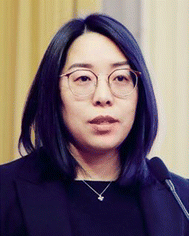Materials Horizons Emerging Investigator Series: Professor Jingjing Duan, Nanjing University of Science and Technology, China
Professor Jingjing Duan achieved her PhD from the School of Chemical Engineering at the University of Adelaide in 2016. From 2016 to 2019, she worked as a research fellow at the University of New South Wales, University of Texas at Austin and University of Adelaide, respectively. Then she joined the School of Energy and Power Engineering, Nanjing University of Science and Technology as a full professor until present. Prof. Duan’s research is devoted to developing energy conversion and storage technologies, including electrolyzers and aqueous CO2 batteries for small molecular conversion of H2O/N2/O2/CO2. She has received several awards, including the “Elsevier Highly Cited Researcher of China” (2021–2023), JMCA Emerging Investigators (2021), Top 2% Scientists Globally (2020–2023), Postgraduate Alumni Medal from the University of Adelaide (2017), Women's Research Excellence (2018) etc. She has published 10 patents and 90 papers in top journals, such as Nat. Commun., J. Am. Chem. Soc., Angew. Chem., Int. Ed., Adv. Mater., Energy Environ. Sci., etc., attracting over 9300 citations with a H-index of 36, with 13 among the “top 1% ESI highly cited papers”. She is also an associate editor on Exploration (Wiley), a young editor on Materials Today Energy, Next Energy, EcoMat, EcoEnergy and Carbon Engineering Science.
Read Professor Jingjing Duan's Emerging Investigator Series article ‘Unlock flow-type reversible aqueous Zn–CO 2 batteries’ ( https://doi.org/10.1039/D4MH00219A ) and read more about her in the interview below:
MH: Your recent Materials Horizons Communication reports a new method for CO 2 capture and energy storage. How has your research evolved from your first article to this most recent article and where do you see your research going in future?
JD: The first article we published in this emerging area of aqueous CO2 batteries reports a pre-saturation strategy to promote the CO2 diffusion in a H-type CO2 battery and thus improve the power density and discharge potential. After which, we think this strategy is not the ultimate method to resolve this bottleneck problem associated with CO2 diffusion, since pre-dissolved CO2 might be consumed after long-time working of CO2 batteries. Then, how to keep the electrolytes from being CO2-saturated all the time is a pressing issue. Accordingly, a flow-type CO2 battery is developed in the communication to resolve the above problem by keeping the saturated electrolyte flowing through the battery continuously. Based on the above discussion, we think this new device configuration of CO2 battery could greatly promote the lab-scale research to practical application and then commercial success.
MH: What aspect of your work are you most excited about at the moment?
JD: The device configuration of this flow-type CO2 battery is the most interesting part.
MH: In your opinion, what are the most important questions to be asked/answered in this field of research?
JD: The power density of aqueous CO2 batteries is still much lower than that of Zn–Air batteries and far behind a value that could be commercialised.
MH: What do you find most challenging about your research?
JD: How to theoretically understand the reaction mechanism on the multi-scale – from the device design, to microenvironment and cathode catalyst design – is the most challenging part.
MH: In which upcoming conferences or events may our readers meet you?
JD: International Congress on Catalysis
MH: How do you spend your spare time?
JD: Discussion with students, colleagues and senior scientists, hiking with family and reading alone.
MH: Can you share one piece of career-related advice or wisdom with other early career scientists?
JD: Follow your heart and insist on what you want.
| This journal is © The Royal Society of Chemistry 2024 |

